Summary:
You probably lock your front door and your car, but what about your mobile phone? Well, if you aren’t doing it now, you should start taking your mobile device security seriously. Your phone contains passwords, data, photos and all types of private information, all of which may leave you vulnerable to hackers.
We use our phones for virtually everything nowadays — from banking to paying for goods and services, browsing the web and watching our favorite shows. This has made us all more vulnerable to cyber threats as fraudsters have new ways of stealing our data.
Here are 15 mobile device security tips to consider to help keep your phone secure:
- Always lock your phone when it’s not in use. Set up Touch ID or Facial Recognition on your device, and back that up with a unique PIN or pattern.
- Don’t download apps from third-party sites. Cybercriminals create “spoof” apps to trick people into downloading malware or spyware onto their device. Only use official apps from Google Play or the App Store.
- Avoid public charging stations unless there is an emergency. Hackers have been known to set up fake charging stations in scams known as “juice jacking.” After you plug in, they can access your phone’s data or install malware on the device.
- In our fast-paced world, it can be tempting to seek out the most convenient internet connection while away from home. Use caution when connecting to public Wi-Fi networks. Cybercriminals can access and monitor your activity if you connect to one of their seemingly trustworthy, “spoof” networks.
- Use a different password for every account you own and don’t save them in your browser. In 2021, there was a 60% password reuse rate amongst those whose credentials had been exposed in more than one breach — the same rate as the previous year. Using passwords across personal and business accounts puts even more people at risk. Use a password manager to help you record and manage unique passwords for every app and test your password strength before using it.
- Try to avoid opening email links, even if you think the sender is familiar. Smartphones are just as susceptible to viruses as computers. According to the FBI, phishing was the most popular cybercrime in 2020, with numbers nearly doubling year-over-year from 2019. Phishing is the most common delivery method for ransomware infections, delivering malware to your phone and your network.
- If you must connect your phone to public Wi-Fi, avoid visiting websites that contain sensitive or financial information, like your bank or credit card’s website. If you have to do this, use a “virtual private network” or VPN, which encrypts your data.
- Install antivirus software on mobile devices. As a best practice for any mobile device — phones, tablets or other — consider adding antivirus software for the additional security it provides against malware or other viruses.
- Always back up your smartphone’s data. If your mobile device gets lost, stolen or destroyed, would you feel safe that your contacts, pictures, apps and email data are secure? Make sure that you sync your phone, so your data is backed up, whether that be on the cloud or to a personal, external hard drive.
- Speaking of lost cell phones, turn on remote tracking in your mobile device settings. Apple users have Find My iPhone, and Android users can enable Find My Device to see the last known location of the device. Both features allow you to remotely wipe your smartphone’s data if it’s stolen or can’t be retrieved.
- Invest in mobile threat defense. This software scans your phone and will alert you to suspicious activity, like rogue applications and fake Wi-Fi networks. It also includes fully-managed restoration if data exposure were to lead to an identity theft incident.
- Enable two–factor authentication (2FA) for your key accounts, like mobile banking apps and peer-to-peer payment apps. This added layer of security may help prevent a thief from being able to wipe out your financial accounts.
- Audit your apps to see what information they are accessing. Mobile apps can be a real threat to your security, with 83% of apps having at least one security flaw. Be cautious about what permissions you grant the apps that you download.
- Do not “Root” your Android or “Jailbreak” your iPhone. This is a process that gives you complete access of your device, but in doing so, removes many of the safeguards that the manufacturers have put in place.
- Always update your phone’s Operating System (OS) when prompted. These updates are meant to protect your device and information.
No smartphones are totally immune to hackers and cybercriminals, but by following the steps above, you can significantly reduce your risk of becoming a victim of fraud.
Identity Security in the Palm of Your Hand
IdentityForce’s award-winning mobile app gives you access to the industry’s top-rated identity theft protection anywhere, any time. Take control of monitoring your sensitive personal information and get alerted to suspicious activity before major damage is done. With features like Mobile Attack Control™ and a Virtual Private Network (VPN), your mobile device is protected with a secure internet connection anywhere you go.




